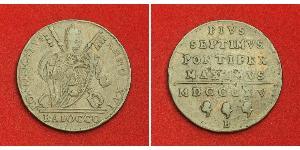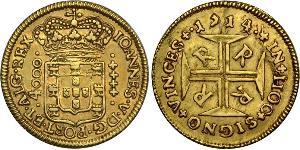(sold for $10.0)
1709, Swiss Cantons, Valais/Sitten. Scarce Billon Silver Batzen Coin. VF
Condition: VF
Mint Year: 1709
Denomination: Batzen
Reference: KM-27 ($55 in VF!)
Material: Billon (low grade silver and bronze alloy)
Diameter: 25mm
Weight: 2.6gm
Obverse: Eagle above coat-of-arms of Sitten (the later canton of Valais), splitting date (17-09).
Legend: PRAEF . ET . COM . REIP . VALLESY
Reverse: Mitred and quartered 4-fold arms, flanked with sword and crozier.
Legend: F . I . SVPERSAXO . EP . SE .
Sion (German: Sitten; Italian: Seduno; Latin Sedunum) is the capital of the Swiss canton of Valais and of the district of Sion.
The Canton of Valais (German: Wallis) is one of the 26 cantons of Switzerland, situated in the southwestern part of the country, around the valley of the Rhône from its headwaters to Lake Geneva, separating the Pennine Alps from the Bernese Alps. The canton is simultaneously one of the driest regions of Switzerland in its central Rhône valley and among the wettest, having large amounts of snow and rain up on the highest peaks found in Switzerland. The canton of Valais is widely known for the Matterhorn and resort towns such as Crans-Montana, Saas Fee and Zermatt. It is composed of 13 districts (hence the 13 stars on the flag) and its capital is Sion.
The Romans called the upper Rhône valley Vallis Poenina. The Vallis Poenina was won by the Romans after a great fight at Octodurus (Martigny) in 57 B.C., and was so thoroughly Romanized that both the Celtic original inhabitants and the Germanic Burgundian invaders of the 5th century, became Romance-speaking peoples. According to a tradition which can be traced back to the middle of the 8th century, the Theban legion was martyred at Agaunum (now Saint Maurice) about 285 or 302. From 888 onwards the lands were part of the kingdom of Jurane Burgundy.
Valais formed part of the kingdom of Transjurane Burgundy, which fell to the Holy Roman Empire in 1032. It became part of the duchy of Burgundia Minor, which was held from the emperors by the house of Zähringen (which became extinct in 1218). In 999, King Rudolph III of Burgundy gave all temporal rights and privileges to the Bishop of Sion, who was later styled praefect and count of the Valais and is still a prince of the Holy Roman Empire. The count-bishops then struggled to defend their area against the Zähringer and then the dukes of Savoy, so that the medieval history of the Valais is inextricably linked with that of the diocese of Sion. The Dukes of Savoy, however, succeeded in winning most of the land west of Sion, while in the upper part of the valley (Upper Valais) there were many feudal lords, such as the lords of Raron, those of La Tour-Chatillon, and the counts of Visp.
About the middle of the 13th century, the large communities (Zenden or tithings) began to develop independence and grow in power. The name Zenden or tithings probably came from a very ancient division of the bishop's manors for administrative and judicial purposes. In the same century the upper part of the valley was colonized by Germans from Hasli in the Canton of Bern. The locals became German speaking, though many Romance local names still remain. In 1354 the liberties of several of the seven Zenden (Sion, Sierre, Leuk, Raron, Visp, Brig and Conches) were confirmed by the Emperor Charles IV.
By the late 14th century, the counts of Savoy acquired the bishopric of Sion. The Zenden resisted his attempts to gather both spiritual and secular power in the valley. In 1375-76, Zenden forces crushed the army of the house of La Tour-Chatillon, and in 1388 utterly defeated the forces of the bishop, the count and his nobles at Visp. The German-speaking Zenden spread further into the valley. Starting in 1384 the Morge stream (a little below Sion) was recognized as the boundary between Savoyard, French-speaking Lower Valais and German-speaking episcopal Upper Valais.
During the Raron affair rebellion in 1414 to 1420, some cantons of the Swiss Confederation took sides in the Valais. Lucerne, Uri and Unterwalden supported the Upper Valais rebels, while Bern supported the noble Raron family. The uprising was successful in driving out the Rarons, and almost brought the Confederation to civil war.
Following the violence of the Raron affair, the canton was the location of the Valais witch trials between 1428 and 1447 in which at least 367 men and women were put to death. This event marks one of the earliest witch scares in late medieval Europe. The phenomenon later spread to other parts of the contintent.
With the election of Walther von Supersax of Conches as bishop in 1457, the German-speaking part of the valley finally won the supremacy. At the outbreak of the Burgundian War in 1475 the bishop of Sion and the Zenden made a treaty with Bern. In November of the same year they seized all Lower or Savoyard Valais up to Martigny. In March 1476, after the victory of Grandson, they advanced and captured St Maurice, Evian, Thonon and Monthey. They had to give up the last three districts in 1477, but won them again in 1536. In the treaty of Thonon in 1569, Monthey, Val d'llliez and Bouveret were permanently annexed to the Valais. These conquered districts in the Lower Valais were always ruled as subject lands by the bishop and Zenden of the Upper Valais. On March 12, 1529, Valais became an associate member (Zugewandter Ort) of the Swiss Confederation.
The Valais resisted the Protestant Reformation, remaining faithful to the Roman Catholic Church. In 1628 the Valais became a republic, the République des Sept Dizains/Republik der Sieben Zehenden, under the guidance of the prince-bishop of Sion and the bailli. The bishop remained in power until 1798 when Napoleon's troops invaded the Valais and declared a Revolutionary République du Valais (March 16) which was swiftly incorporated (May 1) into the Helvetic Republic until 1802 when it became the separate Rhodanic Republic. In 1810 the Rhodanic Republic was annexed by Napoleonic France as the département of Simplon. Independence was restored in 1813, and on August 4, 1815 the Valais finally entered the Swiss confederation as a canton. In 1845, the Valais joined the Catholic separate league (Sonderbund) which led to what is called the Sonderbund War. 99,000 Swiss Federal troops under General Henri Dufour were faced by 79,000 Separatists, but in the end the Valais chose not to fight.
Only 1$ shipping for each additional item purchased!

|
Posted by:
anonymous 2016-10-19 |
1/12 Thaler Duchy of Mecklenburg-Schwerin (1352-1918) Billon
group has 3 coins / 3 prices
⇑
1 Thaler / 32 Shilling Hamburg Silver Ferdinand II, Holy Rom ...
group has 8 coins / 8 prices
⇑















-300-150-Obxhf7_DVzkAAAGMhuiS9kWQ.jpg)








